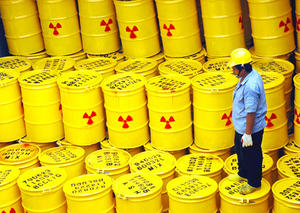Nuclear mattersMagnetic battery to monitor buried nuke waste for 100 years
There is a new way to monitor deeply buried nuclear waste: University of Bristol researchers have developed a “battery” that uses a magnetic spring to create the necessary power to send a message from a repository to the outside world 100 years on; Doug Parr, chief scientist at Greenpeace in the United Kingdom, is unimpressed. “Spent fuel remains hazardous for 240,000 years. It’s good to see there’s a possibility of monitoring for the first 100 years — that just leaves the other 99.96% of the time to worry about”

New battery to monitor buried nuclear waste // Source: treehugger.com
Dealing with radioactive waste is a pressing problem, and if deeply buried repositories are ever built to store it we will need to know what is going on inside them many years after they are sealed. So, with funding from the U.K. nuclear industry, engineers at the University of Bristol have come up with an answer: a “battery” that uses a magnetic spring to create the necessary power to send a message from a repository to the outside world 100 years on.
New Scientistreports that the device will be crucial because getting mains electricity into such sealed dumps will not be allowed — the wiring channels might let flood water in, or radioactive matter out. A chemical battery would be flat long before the first century is up.
The novel power source comprises a 15-centimeter-long carbon-fiber rod which has a powerful neodymium magnet at each end. A third, doughnut-shaped magnet is free to move along the rod, which is surrounded by a copper coil. To “set” the battery, the mobile magnet is forced against one of the fixed magnets, whose poles are arranged to repel each other, and locked into place with a latch that can be released by a timer. The magnet at the other end of the rod is also arranged to repel the mobile magnet.
After 100 years, a timer releases the latch — and the repelled mobile magnet springs quickly past the coil toward the distant magnet, which repels it, sending it back past the coil again. The magnet continues springing back and forth between the repelling magnets until it comes to rest. On each of the magnet’s trips past the coil, however, electromagnetic induction creates a small current in the coil, just enough to charge a bank of capacitors. That power is used to run checks on wireless temperature and radiation sensors via a radio signal - and to transmit the data out of the facility via an antenna.
Making a 100-year timer is a challenge. Peter Constantinou, on the Bristol team, says the latch could be triggered by a radio signal from outside — or an ultra-reliable clockwork mechanism could be developed.
“This invention sounds like the sort of idea we need to look into,” says John Dalton of the U.K.’s Nuclear Decommissioning Authority. Doug Parr, chief scientist at Greenpeace in the United Kingdom, is unimpressed. “Spent fuel remains hazardous for 240,000 years. It’s good to see there’s a possibility of monitoring for the first 100 years — that just leaves the other 99.96% of the time to worry about.”
— Read more in P. Constantinou, “An energy supply unit for an autonomous remote sensor system monitoring stored nuclear waste,” Sensors and Actuators A: Physical 166, no. 1 (March 2011): 52-65
